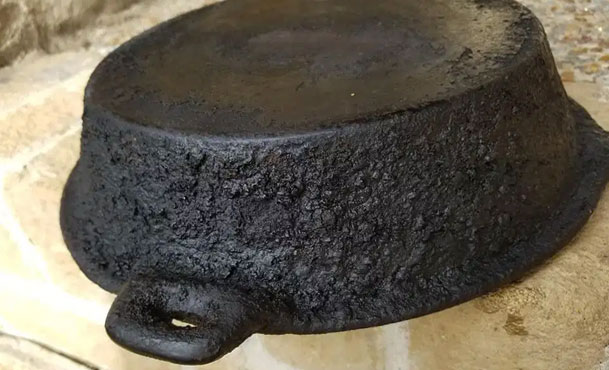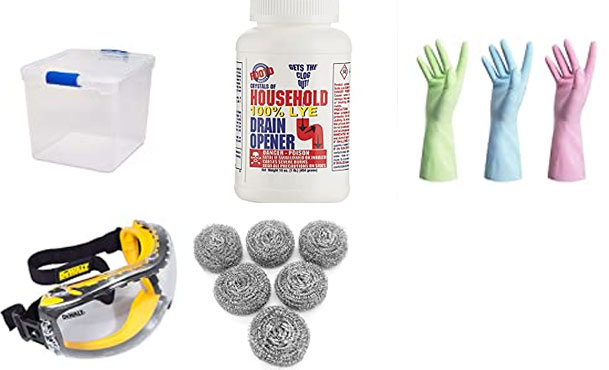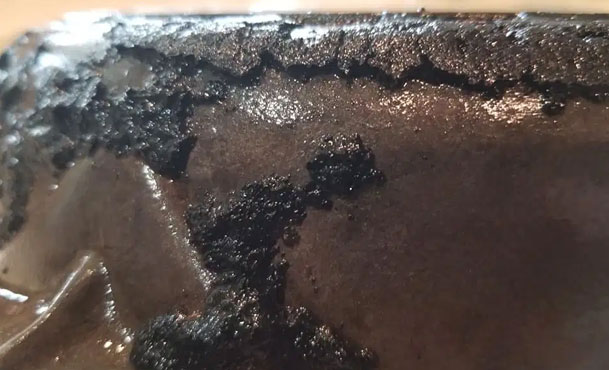
"How to clean cast iron skillet." This sentence is commonly asked on several search engines and social media sites.
I was told by a man that I was cleaning my cast iron all wrong. What I needed was a potato. According to him, you will need to half a potato and add a little salt. Scrub the skillet all away around. The potato will take off rust, old carbon, and seasoning.
So today, I'm teaching you how to clean your cast iron by using potatoes......
Just kidding. I wouldn't do that to you. Save your taters, folks!
A method I use to clean cast iron skillets with build-up carbon and old seasoning, is lye. This sounds extremely terrifying and intimidating at the same time. When I first started cleaning cast iron I was scared to death in using lye. Lye is extremely caustic. Easy-Off oven cleaner is another form of lye.
For the record, this is very safe to use on cast iron. Many people are under the impression that cast iron is porous. Cast iron is nonporous and does not have the ability to absorb like sponges. Evaporation is much different than absorption. Your food is perfectly safe!
For the lye bath, you will need the following:

• 18 gallon storage bin with clip on lid
• 100 percent household lye (2 pounds)
• Rubber cleaning kitchen gloves
I have my lye tank set up in my garage. My tank will be handy during all seasons. In times past my tank froze when the temperature got below freezing. Ice can cause the tank to expand, leading to a puncture in your tank. My tank is set in a well-ventilated area by the garage door and window. The fumes of the lye can be rather strong when the solution is brand new.
For every pound of lye, use 5 gallons of water. For an 18 gallon tank, you will need 2 pounds of lye, and 10 gallons of water. With my tank, I use 4 gallons of water per each pound because I like my lye strong. This will help to speed up the process when I'm needing my cast iron cleaned.
Before you add your lye into the water, have your goggles and your gloves on. In a well-ventilated area, add your lye into your water slowly. Step away each time. This will help you from breathing in any fumes. After you add your lye, allow your mixture to ventilate for a few hours. Lye is very caustic and needs a little time to settle before you start adding in your cast iron.
Lye will not treat rusted cast iron. Lye will only eat away carbon buildup and old seasoning.
Many people choose to use a long piece of wire to wrap around the handle before sticking the skillet into the lye. This helps to prevent your hand from going directly into the lye. Lye won't eat through your gloves, but it is a good idea to replace them monthly.
Add you cast iron skillet carefully into the lye face up Take your wire and hook onto the side of your storage container. Close the lid and wait for about 5 to 7 days. It's a good idea to place a large container of water next to your tank so you can wash your lye off your skillet. Use a steel wool pad to scrub off the gunk. If the carbon has not come off the cast iron skillet completely, return to the tank for another 24 to 48 hours.

Lye also works best during hot weather. The heat will cause lye to work faster. During colder months, the lye will work slower. Lye can be good for up to a year or so. The gunk from your cast iron will settle to the bottom of the container. However, lye can lose its strength after several months. You can add a half a bottle of lye to your mixture when this happens. Also, during the hot months, the water in your lye tank can evaporate. In my tank, the water has evaporated during the hot and humid months. In this case I can add extra water, but it will not cause an explosion. After adding my water, I can use more lye to add to its strength.
Once your skillet is completely cleaned, wash your skillet off completely. Scrub with Bar Keepers Friend and dish soap. Dry off completely with a microfiber towel, and oil down with veggie oil to prevent flash rust. Rub off vigorously with a clean microfiber towel. Make sure there is not any standing oil, and place in the oven at 200 degrees for 15 minutes. Take out again, and scrub the cast iron vigorously. This will prevent any splotching or sticky spots. Return to the oven again, and repeat this step again after 15 minutes. Turn the oven up to 425 degrees for one to two hours. Repeat the seasoning steps two more times in order to get to a nonstick surface.





Note: Due to the dangers of lye, I'm not responsible for any damages that can occur.
